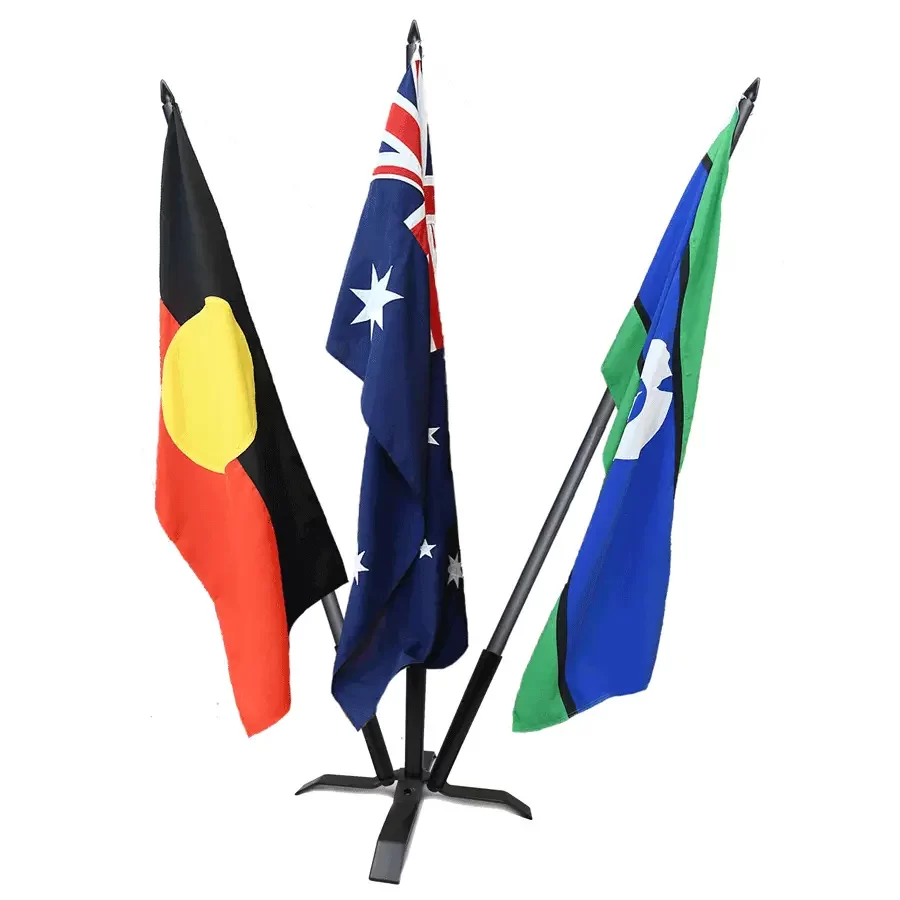Tasmania
Tasmania (Tas) is an island state in Australia. It is located 240 km (150 mi) to the south of the Australian mainland, separated from it by the Bass Strait. The state encompasses the main island of Tasmania, the 26th-largest island in the world, and the surrounding 1000 islands. It is Australia’s least populated state. The state capital and largest city in Tasmania is Hobart, with around 40 per cent of the population living in the Greater Hobart area.
Read more on Tasmania https://en.wikipedia.org/wiki/Tasmania
Map of Tasmania
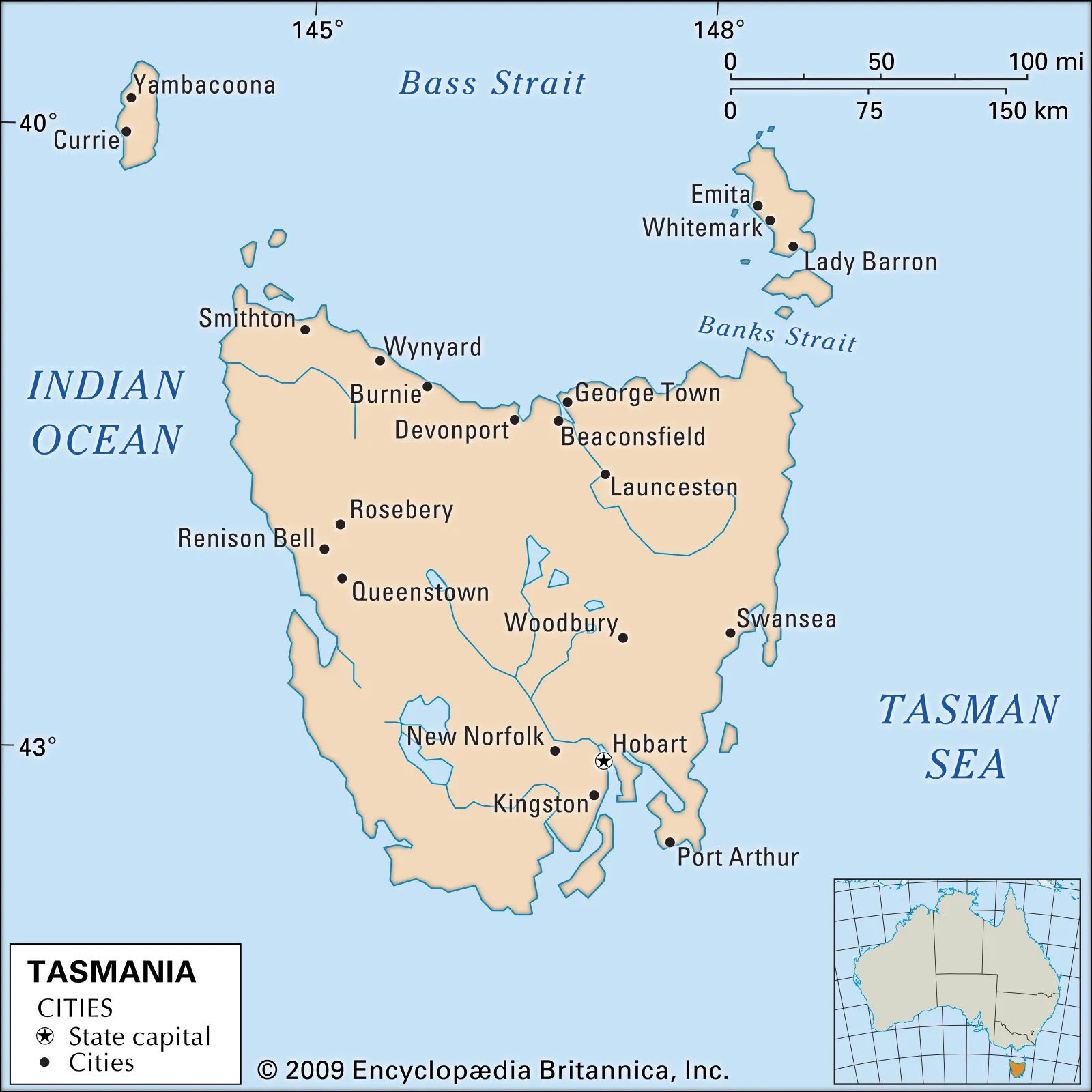
For more on the map of Tasmania https://www.britannica.com/place/Tasmania
Coat of Arms for Tasmania
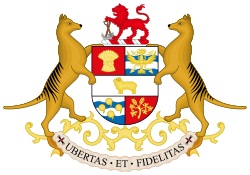 The coat of arms of Tasmania is the official symbol of the Australian state and island of Tasmania. It was officially granted by King George V in May 1917. The shield features significant examples of the Tasmanian industry: a sheaf of wheat, hops, a ram and apples. It is surmounted by a red lion that also features on the State badge. The shield is supported by two thylacines (Tasmanian tigers/wolves) with a motto beneath, Ubertas et Fidelitas, which is Latin for “Fertility and Faithfulness”.
The coat of arms of Tasmania is the official symbol of the Australian state and island of Tasmania. It was officially granted by King George V in May 1917. The shield features significant examples of the Tasmanian industry: a sheaf of wheat, hops, a ram and apples. It is surmounted by a red lion that also features on the State badge. The shield is supported by two thylacines (Tasmanian tigers/wolves) with a motto beneath, Ubertas et Fidelitas, which is Latin for “Fertility and Faithfulness”.
For more on Tasmania’s Coat of Arms https://en.wikipedia.org/wiki/Coat_of_arms_of_Tasmania
Flag for Tasmania
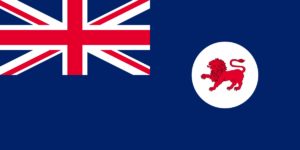 The current state flag of Tasmania was officially adopted following a proclamation by Tasmanian colonial Governor Sir Frederick Weld on 25 September 1876. The flag consists of a defaced British Blue Ensign with the state badge located in the fly. The badge is a white disk with a red lion passant in the centre of the disk. There is no official record of how the lion came to be included on the flag, but it is assumed that the red lion is a reference to Great Britain.
The current state flag of Tasmania was officially adopted following a proclamation by Tasmanian colonial Governor Sir Frederick Weld on 25 September 1876. The flag consists of a defaced British Blue Ensign with the state badge located in the fly. The badge is a white disk with a red lion passant in the centre of the disk. There is no official record of how the lion came to be included on the flag, but it is assumed that the red lion is a reference to Great Britain.
For more on Tasmania’s Flag https://en.wikipedia.org/wiki/Flag_of_Tasmania
Emblems of Tasmania
Animal Emblem
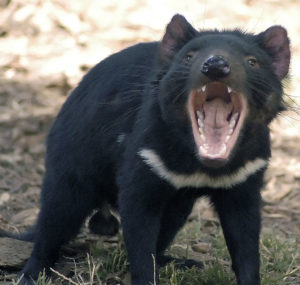 The Tasmanian devil is a carnivorous marsupial of the family Dasyuridae. Until recently, it was only found on the island state of Tasmania, but it has been reintroduced to New South Wales in mainland Australia, with a small breeding population. The size of a small dog, the Tasmanian devil became the largest carnivorous marsupial in the world, following the extinction of the thylacine in 1936.
The Tasmanian devil is a carnivorous marsupial of the family Dasyuridae. Until recently, it was only found on the island state of Tasmania, but it has been reintroduced to New South Wales in mainland Australia, with a small breeding population. The size of a small dog, the Tasmanian devil became the largest carnivorous marsupial in the world, following the extinction of the thylacine in 1936.
Bird Emblem
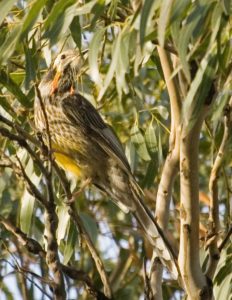 The yellow wattlebird, the unofficial bird emblem for Tasmania, is a species of bird in the honeyeater family Meliphagidae. Other names include the long wattlebird or Tasmanian wattlebird.
The yellow wattlebird, the unofficial bird emblem for Tasmania, is a species of bird in the honeyeater family Meliphagidae. Other names include the long wattlebird or Tasmanian wattlebird.
Floral Emblem
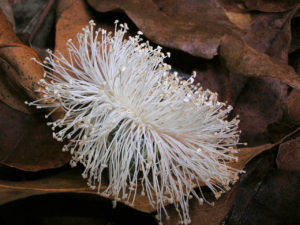 Eucalyptus globulus, commonly known as southern blue gum or blue gum, is a species of tall, evergreen tree endemic to southeastern Australia. This Eucalyptus species has mostly smooth bark, juvenile leaves that are whitish and waxy on the lower surface, glossy green, lance-shaped adult leaves, glaucous, ribbed flower buds arranged singly or in groups of three or seven in leaf axils, white flowers and woody fruit.
Eucalyptus globulus, commonly known as southern blue gum or blue gum, is a species of tall, evergreen tree endemic to southeastern Australia. This Eucalyptus species has mostly smooth bark, juvenile leaves that are whitish and waxy on the lower surface, glossy green, lance-shaped adult leaves, glaucous, ribbed flower buds arranged singly or in groups of three or seven in leaf axils, white flowers and woody fruit.
There are four subspecies, each with a different distribution across Australia, occurring in New South Wales, Victoria and Tasmania. The subspecies are Victorian blue gum, Tasmanian blue gum, Maiden’s gum, and Victorian eurabbie.
Mineral Emblem
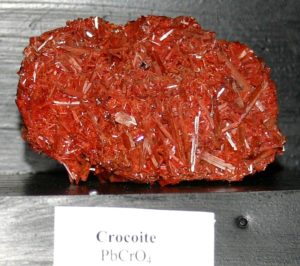 Crocoite is a mineral consisting of lead chromate, PbCrO4, and crystallising in the monoclinic crystal system. It is identical in composition to the artificial product chrome yellow used as a paint pigment. Crocoite is commonly found as large, well-developed prismatic adamantine crystals, although in many cases is poorly terminated. Crystals are of bright hyacinth-red colour, translucent, and have an adamantine to vitreous lustre. On exposure to UV light, some of the translucency and brilliancy is lost. The streak is orange-yellow; Mohs hardness is 2.5–3, and the specific gravity is 6.0.
Crocoite is a mineral consisting of lead chromate, PbCrO4, and crystallising in the monoclinic crystal system. It is identical in composition to the artificial product chrome yellow used as a paint pigment. Crocoite is commonly found as large, well-developed prismatic adamantine crystals, although in many cases is poorly terminated. Crystals are of bright hyacinth-red colour, translucent, and have an adamantine to vitreous lustre. On exposure to UV light, some of the translucency and brilliancy is lost. The streak is orange-yellow; Mohs hardness is 2.5–3, and the specific gravity is 6.0.
For more on Tasmania’s Emblems https://en.wikipedia.org/wiki/Symbols_of_Tasmania
Colour Emblem
Bottle green, Yellow and Maroon
For more on the Colour Emblems https://en.wikipedia.org/wiki/Australian_state_and_territory_colours
Islands Governed by Tasmania
King Island
-
-
- Location: Bass Strait, between mainland Australia and north-west Tasmania
- Population: ~1,600
- Governed by: Tasmania, Australia
-
Situated in the wild Bass Strait, King Island is part of Tasmania and is renowned for its world-class dairy products, windswept coastal landscapes, and historic shipwreck sites. Unlike Australia’s external territories, King Island is part of the King Island Council under the State of Tasmania, but it stands out as a destination with its own distinct charm and rugged beauty.
This remote, fertile island is a favourite for foodies, nature lovers, surfers, and golfers alike. It blends natural isolation with genuine community hospitality.
Highlights:
-
-
- Gourmet Produce:
Home to the famous King Island Dairy, known for artisan cheeses, and producers of fresh seafood (especially lobster), beef, and honey. Local cafes and restaurants serve up paddock-to-plate meals. - Shipwreck Coast:
Over 60 shipwrecks occurred around King Island during the 19th and early 20th centuries. Sites like the Cataraqui Memorial mark Australia’s worst civil maritime disaster. - Cape Wickham Lighthouse:
The tallest lighthouse in the Southern Hemisphere, surrounded by dramatic coastline and golf greens. - Golfing:
The island boasts two top-rated courses: Cape Wickham Links and Ocean Dunes—regularly ranked among the world’s best coastal golf courses. - Surfing and Nature Walks:
World-class surf breaks (like Martha Lavinia Beach), scenic bushwalking trails, and prolific birdlife make it a haven for adventurers and eco-tourists.
- Gourmet Produce:
-
Local Culture:
King Island has a proud agricultural heritage, a thriving creative arts scene, and a deep connection to the sea. The community is close-knit and welcoming, with local markets, galleries, and festivals held throughout the year.
Getting There:
-
-
- Regular flights operate from Melbourne, Launceston, and Burnie (Wynyard).
- Ferries may carry freight, but there is no regular passenger ferry service.
-
King Island is a hidden gem of Tasmania that offers a unique blend of culinary indulgence, coastal adventure, and island tranquillity—all just a short flight from the mainland.
Flinders Island
-
-
- Location: Bass Strait, northeast of Tasmania
- Population: ~1,000
- Governed by: Tasmania, Australia (Flinders Council)
-
Flinders Island is the largest of the Furneaux Group, a chain of more than 50 islands scattered across the Bass Strait. Rugged and remote, Flinders Island is a true escape into nature, blending untouched beaches, mountainous landscapes, rich wildlife, and a deep Aboriginal and colonial history.
Though not an external territory, Flinders Island holds a unique place in Australia’s island narrative, offering seclusion, story, and scenery in equal measure. It’s perfect for bushwalkers, birdwatchers, photographers, and those seeking peace far from the city’s pace.
Highlights:
-
-
- Mount Strzelecki:
The island’s highest peak (756m) offers spectacular views after a rewarding climb through native bushland. It’s part of the Strzelecki National Park. - Trousers Point:
One of Tasmania’s most beautiful beaches, with white sands, turquoise water, and views of the surrounding granite mountains. - Wildlife Watching:
Home to wombats, wallabies, echidnas, and over 100 bird species, including rare seabirds and migratory shorebirds. It’s also one of the best places to spot the elusive Tasmanian pademelon in the wild. - Aboriginal Heritage & European History:
The island has deep Palawa (Tasmanian Aboriginal) roots and is part of the historical tragedy of the 19th-century Wybalenna settlement. Today, visitors can explore historical sites and learn more about the island’s past through local museums and tours. - Fishing & Kayaking:
Excellent for recreational fishing, boating, and kayaking through estuaries, bays, and around offshore islands. - Local Produce & Artisans:
Flinders has a growing food culture, featuring fresh seafood, lamb, organic produce, and artisan goods. Stop in at local markets or enjoy a meal at one of the island’s cosy cafés.
- Mount Strzelecki:
-
Lifestyle & Culture:
Flinders Island offers an authentic, small-community atmosphere. Life moves at a slower pace, shaped by the sea, farming, and a strong connection to nature. Islanders are friendly and self-sufficient, often wearing many hats as farmers, artists, and hosts.
Getting There:
-
-
- Flights are available from Melbourne, Launceston, and Bridport (small aircraft).
- Ferry services operate between Bridport (Tasmania) and Lady Barron (Flinders Island) for vehicles and freight, with occasional passenger trips.
-
Why Visit Flinders Island?
Flinders Island is where solitude meets spectacle—dramatic granite peaks, quiet beaches, and a wild spirit unspoiled by tourism. It’s ideal for those who love outdoor adventure, local heritage, and uninterrupted nature.
Cape Barren Island
-
-
- Location: Bass Strait, part of the Furneaux Group, east of Flinders Island
- Population: ~70 (mostly Palawa Aboriginal community)
- Governed by: Tasmania, Australia (Flinders Council)
-
Cape Barren Island is the second-largest island in the Furneaux Group, situated in the Bass Strait between mainland Australia and Tasmania. Unlike its more-visited neighbour, Flinders Island, Cape Barren is a closed Aboriginal community and holds deep cultural and historical significance for the Palawa people, Tasmania’s Aboriginal community.
This windswept island features mountains, wetlands, lagoons, and rich native bushland. It’s largely undeveloped and not a traditional tourist destination, but it plays a vital role in Tasmania’s Indigenous heritage and the history of Aboriginal self-determination.
Highlights & Features:
-
-
- Mount Munro:
The island’s highest point (715 m) offers panoramic views across the Furneaux Islands and the wild Bass Strait. It holds cultural significance for the local Aboriginal people. - Aboriginal Community:
Cape Barren Island was one of the earliest sites of permanent Aboriginal resettlement in Tasmania post-European colonisation. Today, it remains home to a proud and resilient Palawa community that maintains cultural practices and land connection. - Wildlife & Natural Beauty:
The island is home to diverse birdlife, including black swans, wedge-tailed eagles, and sea eagles, as well as wallabies, wombats, and other native species. Coastal wetlands and lagoons provide critical habitats for breeding and migratory birds. - Conservation & Culture:
Much of the island is managed as Aboriginal freehold land, focusing on sustainable land use and cultural preservation. Hunting, mutton birding (shearwater harvesting), and land management practices continue to follow traditional knowledge.
- Mount Munro:
-
Visitor Information:
-
-
- Access is restricted.
Cape Barren Island is not generally open to tourists. Visitors must receive permission from the Aboriginal Land Council of Tasmania before entering, and accommodation or services are extremely limited. - Transport:
Charter flights from Launceston or Bridport (Tasmania) land at the small Cape Barren airstrip. Sea access is limited and not recommended for casual visitors.
- Access is restricted.
-
Why It Matters:
Cape Barren Island is not a tourist destination, but it is a place of profound cultural, environmental, and historical significance. It tells a story of Aboriginal survival, adaptation, and resilience, offering insight into Tasmania’s true and continuing Indigenous heritage.
For those studying Aboriginal history, land rights, or remote community living, Cape Barren Island represents an important chapter in Australia’s national story
